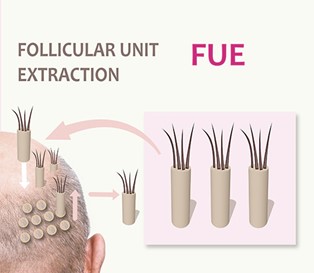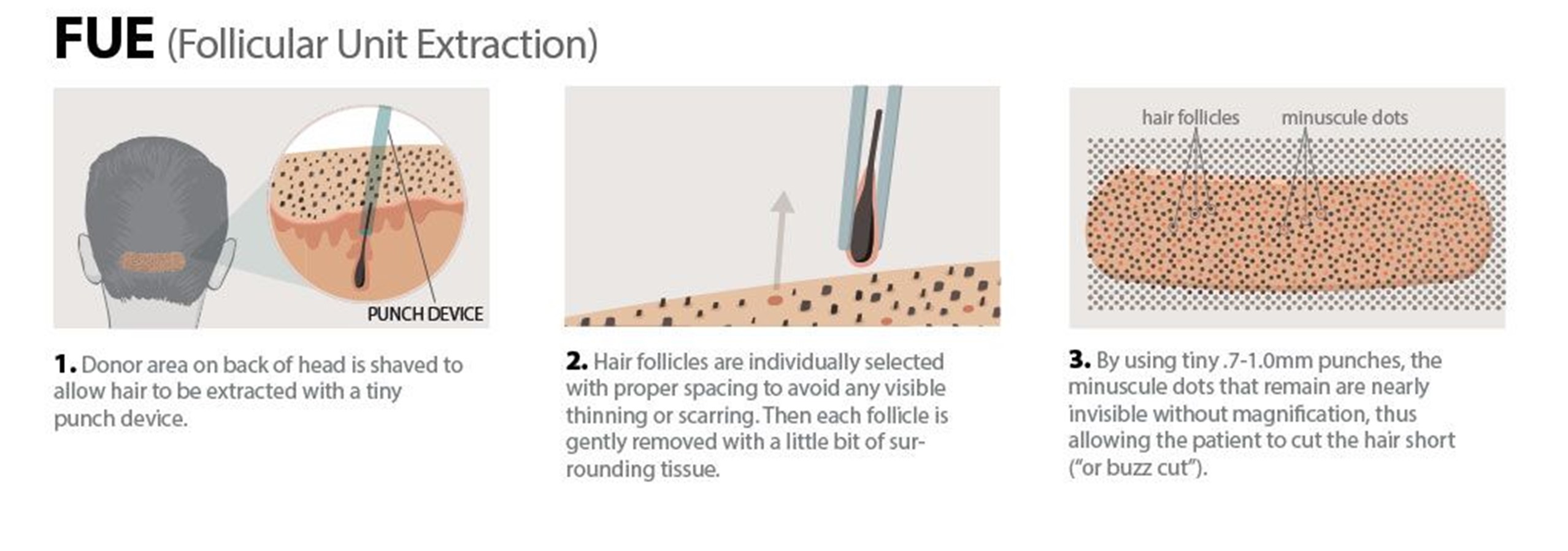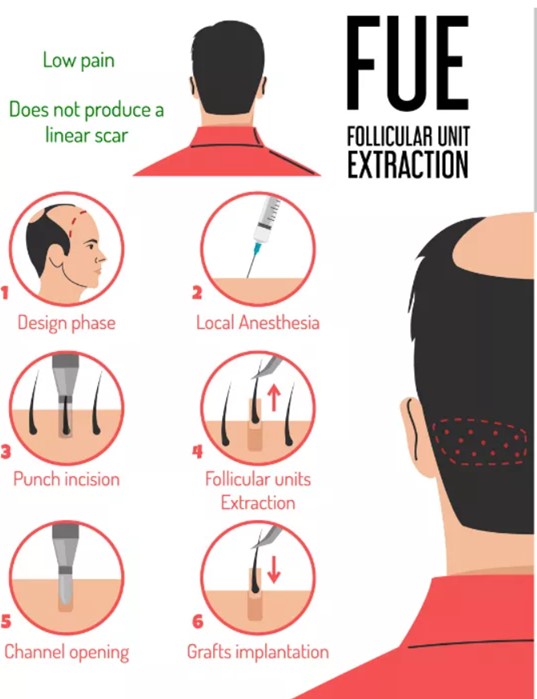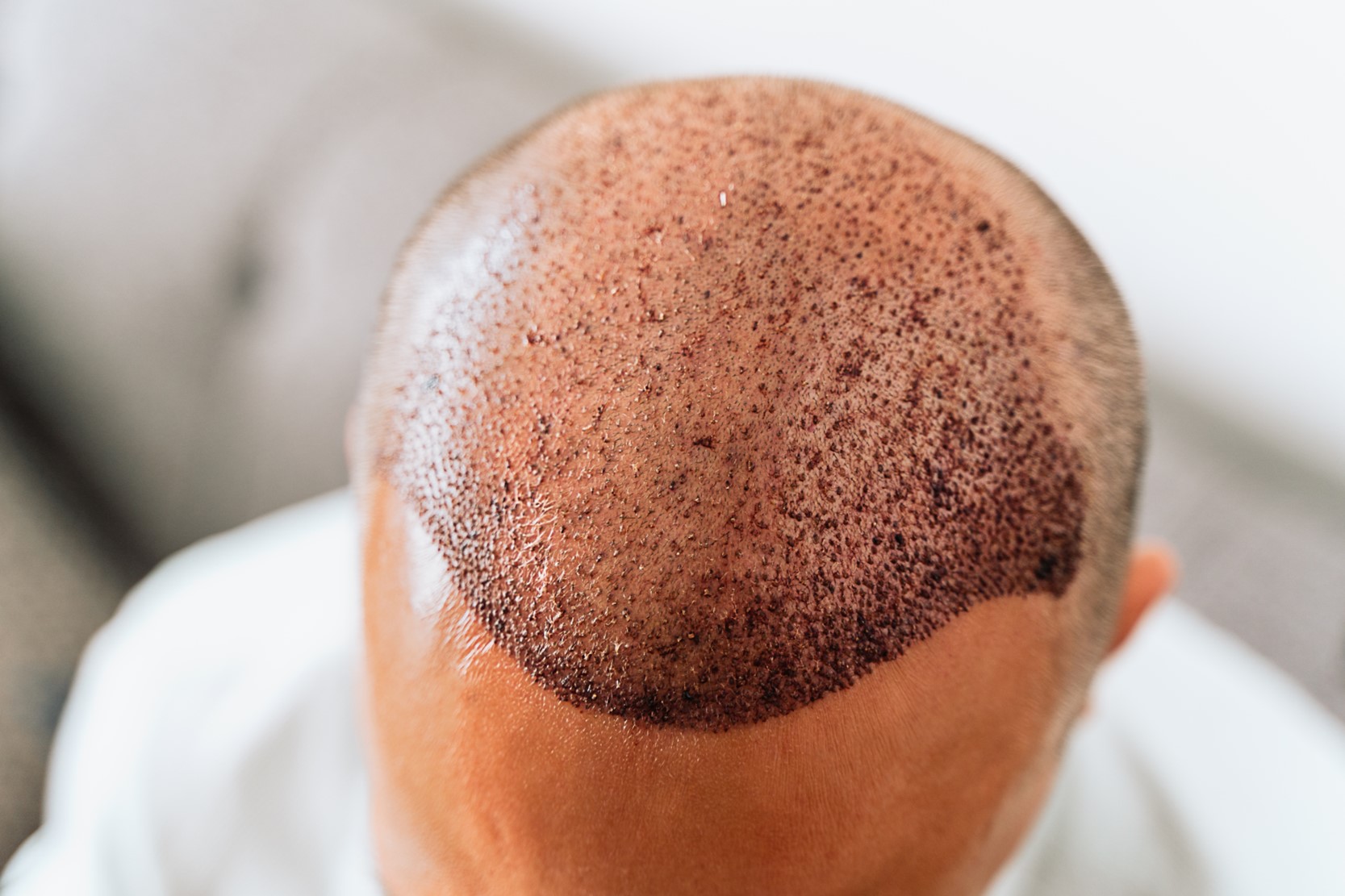What is a FUE Hair Transplant?
Introduction to FUE Hair Transplant
Follicular Unit Extraction (FUE) is a modern hair transplantation technique that has gained immense popularity due to its minimally invasive nature and effective results. Unlike traditional hair transplant methods, FUE involves extracting individual hair follicles from a donor area and implanting them into the recipient site, providing a natural look without visible scarring. This guide aims to provide a detailed understanding of FUE hair transplants, covering everything from the basics to post-operative care.
Comprehensive Guide to FUE Hair Transplants
- Hair Certain Canada
- 13 minutes
Table of Contents
What is FUE (Follicular Unit Extraction)?
FUE, or Follicular Unit Extraction, is a cutting-edge hair restoration procedure. Unlike traditional methods like Follicular Unit Transplantation (FUT), which involve removing a strip of scalp, FUE involves extracting individual hair follicles directly from the donor area (usually the back of the head) using a micro-punch tool. These follicles are then meticulously implanted into the thinning or balding areas, ensuring a natural appearance.

Benefits of FUE Hair Transplant
FUE transplants offer a permanent solution to hair loss, restoring not only hair but also confidence and self-esteem. They are suitable for individuals experiencing various types of hair loss, from male and female pattern baldness to hair thinning caused by stress, hormonal changes, or medical conditions. The natural-looking results and minimal downtime make FUE an appealing option for many. Benefits include:
- Minimally Invasive: FUE does not require large incisions, reducing the risk of scarring and allowing for a faster recovery and minimal discomfort.
- Natural Results: Since individual follicles are transplanted, the results look natural and blend seamlessly with existing hair.
- No Linear Scars: Unlike FUT, which can leave a noticeable scar, FUE leaves tiny dot-like scars that are virtually invisible.
- Quick Recovery: Most patients can return to their routine within a few days, with only minor redness or swelling.
Ideal Candidates for FUE Hair Transplant
FUE is an excellent option for individuals experiencing moderate to severe hair thinning or male pattern baldness. Ideal candidates include:
- Those with good hair density in the donor area.
- Individuals who prefer shorter hairstyles.
- Patients looking for a solution with minimal downtime.
- Those seeking a more discreet procedure without visible scarring.
Preparing for an FUE Procedure
Before undergoing FUE, it’s essential to follow certain pre-surgery instructions. Patients are advised to:
- Avoid alcohol and smoking two weeks prior.
- Refrain from taking blood-thinning medications.
- Wash their hair thoroughly on the day of surgery.
- Discuss any concerns with their surgeon.
The FUE Procedure Day: What to Expect
On the day of the procedure:
- Patients arrive at the clinic, where local anesthesia is administered.
- The entire procedure may take 4 to 8 hours, depending on the number of grafts required.
- Patients are awake but comfortable throughout the process.
Step-by-Step Process of FUE Hair Transplant
The FUE procedure works by strategically extracting and implanting hair follicles to create a natural appearance. The steps are as follows:
- Consultation and Assessment: The process begins with a thorough consultation to assess the patient’s hair loss pattern, donor hair quality, and overall suitability for the procedure.
- Pre-Operative Instructions: Patients receive instructions on how to prepare for the surgery, including avoiding certain medications and alcohol.
- Hairline Design: The surgeon designs the hairline and discusses the desired outcome with the patient.
- Preparation of the Donor Area: On the day of the surgery, the donor area is shaved and sterilized. Local anesthesia is administered to ensure the patient is comfortable throughout the procedure.
- Extraction of Hair Follicles: The surgeon uses a specialized micro-punch tool to extract individual hair follicles from the donor area. Each follicle is carefully harvested to minimize damage and maximize the chances of successful implantation.
- Preparation of the Recipient Area: The balding or thinning areas of the scalp are prepared, and tiny incisions are made where the extracted follicles will be implanted. This step is crucial to ensure that the new hair grows in the desired direction and density.
- Implantation of Hair Follicles: The harvested follicles are meticulously implanted into the recipient area. The surgeon strategically places each follicle to achieve a natural hairline and even coverage.
- Post-Procedure Care and Recovery: After the procedure, patients receive detailed aftercare instructions. This includes recommendations for washing the scalp, avoiding strenuous activities, and protecting the treated areas from direct sunlight.

Recovery Timeline and What to Expect
- Days 1-3: Mild swelling and redness may occur. Patients should rest and avoid touching the treated areas.
- Days 4-7: Tiny scabs form around the implanted follicles. These scabs naturally fall off within a week.
- Weeks 2-4: The transplanted hair may shed during this period—this is a normal part of the process known as “shock loss.”
- Months 3-6: New hair growth begins to appear. The hair will gradually thicken over time.
- Months 9-12: Full results become visible, with significant improvement in hair density and coverage.
Cost of FUE Hair Transplant: Factors to Consider
The cost of an FUE hair transplant can vary depending on several factors:
- Location: The cost can differ significantly between countries and cities.
- Experience of the Surgeon: Highly experienced surgeons may charge a premium for their expertise. In fact, many clinics use technicians to do much of the work, which significantly reduces costs but ads to disadvantages and quality control.
- Number of Grafts: The total number of grafts needed to achieve the desired results influences the overall cost.
- Clinic Reputation: Reputable clinics with state-of-the-art technology may have higher fees.
On average, the cost of an FUE procedure can range from $4,000 to $18,000. It’s essential to consider not just the cost but also the quality and safety of the clinic.
Please review our guide on Hair Transplant costs in Canada
Finding a Qualified Surgeon
Selecting the right surgeon is crucial for a successful FUE hair transplant. Here are some tips for finding a qualified professional:
- Credentials: Ensure the surgeon is certified, in good standing and specializes in hair restoration.
- Experience: Look for a surgeon with extensive experience
- Positive Reviews: Now a days, it is easy to review google, yelp or other medical portal reviews to determine what patients have to say about their experience.
- Before and After Photos: Review before and after photos of previous patients to assess the surgeon’s skill.
- Ask to speak with prior patience: Ask the clinic to provide you with a number of patients you can call yourself.
- Consultation: Schedule a consultation to discuss your goals and evaluate the surgeon’s approach.
Potential Risks and Side Effects
While FUE is generally safe, it’s not entirely risk-free. Some of the potential side effects include:
- Temporary redness, swelling, or bruising.
- Folliculitis (inflammation of hair follicles).
- Minor scarring at the donor sites.
- Shock loss, where transplanted hair sheds temporarily before regrowth.
Most of these side effects are temporary and resolve within a few weeks.
Misconceptions About FUE Hair Transplant
#1: Hair Transplants are Only for Men
FUE is suitable for both men and women experiencing hair loss. Women with thinning hair, especially around the hairline, can benefit significantly from this procedure.
#2: Transplanted Hair Looks Fake
Thanks to modern techniques, FUE results are incredibly natural. The hair grows just like your natural hair, allowing you to cut, dye, and style it as desired.
#3: The Results are Immediate
While you’ll notice a difference immediately after the procedure, full results take 9-12 months to fully manifest. Patience is key!
What Is the Difference Between FUE and FUT?
FUE and Follicular Unit Transplantation (FUT) are two different methods of hair restoration:
- FUE involves extracting individual hair follicles, which minimizes scarring and recovery time.
- FUT involves removing a strip of scalp from the donor area and dissecting it into individual grafts. This method may leave a linear scar but can be more efficient for large areas of hair loss.
Why Choose FUE Over FUT?
Many patients prefer FUE over FUT because it:
- Minimizes Scarring: FUE leaves tiny, almost invisible scars compared to the linear scar from FUT.
- Faster Recovery: FUE has a shorter recovery period, allowing patients to return to normal activities more quickly.
- Less Invasive: FUE is less invasive, resulting in less post-operative discomfort.
Possible Disadvantages of FUE hair transplants
While FUE hair transplants offer numerous benefits, there are also some disadvantages to consider:
- Cost: FUE is generally more expensive than other hair restoration techniques due to the time and precision required for extracting individual follicles.
- Time-Consuming: The procedure can be lengthy, especially if a large number of grafts are needed, as each follicle is extracted and implanted individually.
- Skill-Dependent: The success of FUE largely depends on the skill and experience of the surgeon. Poor technique can lead to less satisfactory results.
- Limited Donor Supply: FUE relies on the availability of sufficient donor hair. In cases of extensive hair loss, finding enough donor follicles can be challenging.
- Possible Need for Multiple Sessions: Some patients may require multiple sessions to achieve their desired density and coverage, which can increase the overall cost and time commitment.
- Temporary Shedding: Post-procedure, patients might experience a temporary shedding of transplanted hair, known as “shock loss.” While this is usually temporary, it can be concerning.
- Post-Operative Discomfort: Although the procedure is minimally invasive, some discomfort, swelling, and redness in the donor and recipient areas can occur during the recovery period.
- Scarring: While FUE minimizes scarring compared to other methods, tiny white scars may still be visible, especially in patients with darker skin tones.
- Patience Required for Results: Full results from an FUE hair transplant can take up to 12-18 months to become visible, requiring patience from the patient.
- Not Suitable for All Types of Hair Loss: FUE may not be suitable for patients with certain types of hair loss or those with diffuse hair thinning where donor hair quality is not optimal.
It’s important to weigh these disadvantages against the potential benefits and consult with a qualified hair transplant surgeon to determine if FUE is the right choice for you.
Is FUE Hair Transplant Right for You?
FUE hair transplant is a powerful solution for those looking to restore their hair and confidence. With minimal scarring, quick recovery, and natural-looking results, it’s no wonder FUE has become the preferred method for hair restoration.
Remember, while FUE is an effective solution, consulting with a qualified surgeon is essential to determine the best approach for your specific needs. Take the time to research and choose a reputable clinic to ensure a successful outcome.


Frequency Asked Questions
Follicular Unit Extraction (FUE) is a hair restoration technique where individual hair follicles are extracted from a donor area (usually the back of the head) and implanted into areas with thinning or no hair, resulting in a natural look.
FUE involves extracting individual hair follicles, leaving minimal scarring, while FUT (Follicular Unit Transplantation) involves removing a strip of scalp and dissecting it into grafts, which may leave a linear scar.
Ideal candidates are those experiencing hair loss with sufficient donor hair, good overall health, and realistic expectations. Typically, individuals in their mid-20s or older are preferred. The typical patient is in their 30s, 40s & 50s.
The procedure can take anywhere from 4 to 12 hours, depending on the number of grafts needed.
The cost varies based on factors such as the number of grafts, the surgeon's experience, and the clinic's location. It typically ranges from $4,000 to $18,000.
During the consultation, the surgeon will assess your hair loss, discuss your goals, review your medical history, and design a treatment plan tailored to your needs.
The procedure is performed under local anesthesia, so you shouldn’t feel pain during the process. Some discomfort may be experienced during the recovery period.
Recovery typically takes about 7 to 10 days. Most patients can return to normal activities within a few days, but strenuous activities should be avoided for at least a week.
Potential risks include infection, scarring, swelling, bruising, and temporary shedding of transplanted hair (shock loss). These complications are rare and manageable with proper care.
Most patients can return to work within 2 to 5 days post-procedure, depending on their job and comfort level.
Local anesthesia is used to numb the donor and recipient areas, ensuring that the procedure is pain-free.
FUE leaves tiny, almost invisible scars that are typically not noticeable, even with short haircuts.
The number of grafts needed varies based on the extent of hair loss and desired density. An average session may involve 2,000 to 4,000 grafts.
Yes, FUE can be used to restore hair in other areas like the beard, eyebrows, and chest.
Initial growth starts around 3 to 4 months post-surgery, with full results visible after 12 to 18 months.
Look for certified surgeons with extensive experience in hair restoration, positive patient reviews, and before-and-after photos of past procedures.
Yes, the results are permanent. The transplanted hair follicles are resistant to the hormone that causes hair loss, ensuring long-lasting results.
Yes, women experiencing hair loss or thinning hair can also benefit from FUE hair transplants.
Follow your surgeon's pre-operative instructions, which may include avoiding certain medications, alcohol, and smoking. Maintain a healthy diet and get plenty of rest.
In some cases, patients may require multiple sessions to achieve their desired density or to cover larger areas of hair loss.
After the FUE procedure, avoid strenuous activities, swimming, direct sun exposure, and wearing hats or helmets for a specified period to ensure optimal healing.
Your surgeon will provide specific instructions, but typically, you can gently wash your hair a few days after the procedure using a mild shampoo.
It’s recommended to avoid strenuous exercise for at least 7 to 10 days post-procedure to prevent any complications and ensure proper healing.
Yes, when performed by a skilled surgeon, FUE transplants produce very natural-looking results, as the grafts are placed following your natural hair growth pattern.
While rare, factors such as poor surgical technique, inadequate post-operative care, or the body rejecting the grafts can result in less than optimal outcomes. Selecting a reputable surgeon minimizes these risks.
Post-operative medications may be prescribed to reduce inflammation, prevent infection, and support hair growth. Follow your surgeon’s recommendations for the best results.
It’s best to wait until your scalp has fully healed before coloring your hair. Consult with your surgeon for specific guidelines, but typically, you should wait at least a few weeks post-procedure.





